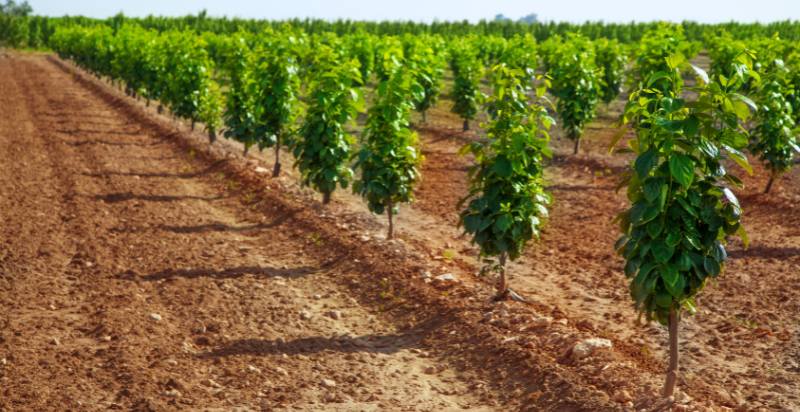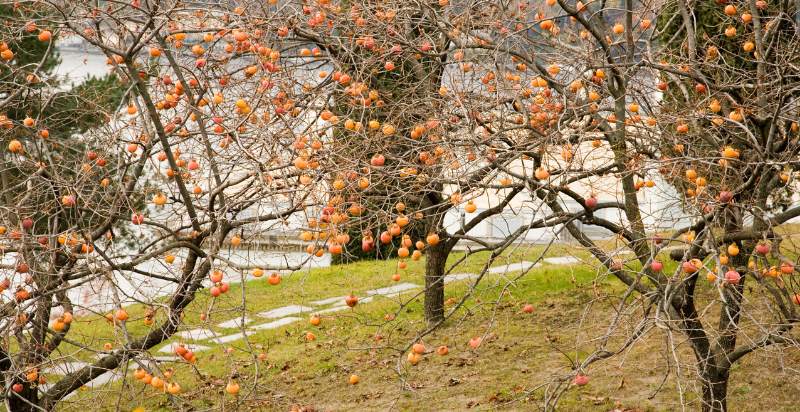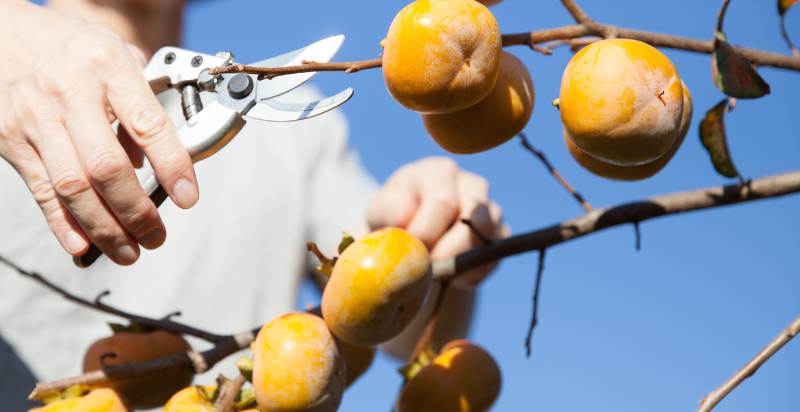Persimmon trees are a unique and popular landscape choice due to their distinct characteristics. They are deciduous trees, meaning they lose their leaves in the fall, but can range in color from deep greens in the summer to oranges or yellows in the fall.
These trees produce edible fruit that is sweet and juicy when ripe, making them attractive additions to any garden. This article will explore the many benefits of growing persimmon trees and which varieties may be best suited for your landscape.
What Are Persimmon Trees?
Persimmon trees are deciduous fruit trees native to Asia but can grow in many parts of the world. They are usually small to medium-sized trees that can reach heights of up to 25 feet and have an average lifespan of 40 years or more. The leaves of persimmon trees vary in shape, size, and color, depending on the variety. The bark is typically gray-brown or reddish-brown and smooth with shallow ridges.
History & Origin Of Persimmon Trees:
The persimmon tree has an interesting history dating back thousands of years ago. Native Americans were among some of the first people to cultivate these fruits for their sweet, juicy taste. The persimmon tree is featured in many Native American myths and stories and symbolizes good luck, health, and prosperity.
The persimmon tree was introduced to Europe in the 16th century by Spanish explorers who brought the trees back from Asia. Today, these trees can be found worldwide in commercial orchards and small backyard gardens.
Types of Persimmon Trees:
A few different types of persimmon trees can be found growing in the wild or cultivated by gardeners. The common persimmon (Diospyros kaki), also known as the Japanese persimmon, is one of the most popular varieties and is native to China and Japan. This variety produces sweet, orange-red fruits with a single seed in the center.
Other varieties include the American persimmon (Diospyros virginiana), indigenous to North America and producing yellowish-orange fruits, and the Chinese or Korean persimmon tree (Diospyros lotus), which has small, yellow-orange fruits with an almond-like flavor.
Benefits of Growing Persimmon Trees:
There are many benefits to growing persimmon trees in your garden. These include:
- Edible Fruit: The most obvious benefit of growing persimmon trees is that you can enjoy their sweet fruits. Persimmons are an excellent source of vitamins and minerals, making them nutritious for any diet.
- Ornamental Appeal: In addition to the edible fruit, persimmon trees are attractive additions to any landscape with their lush foliage and vibrant colors in the fall.
- Low Maintenance: With few pests or diseases impacting them, persimmon trees require very little maintenance and can be grown without pesticides or fertilizers.
- Long Lifespan: Persimmon trees have a long life span of up to 40 years or more, making them an excellent choice for those who want to enjoy their trees for many years.
- Adaptability: Persimmon trees are extremely adaptable and can be grown in most soils and climates with minimal effort.
Which Varieties are Best for Growing?
The best varieties of persimmon trees for growing depend on where you live, what kind of climate you have, and what type of fruit you want to produce. For those who live in warmer climates, the common persimmon (Diospyros kaki) is a good choice as it produces sweet, orange-red fruits and thrives in areas that receive full sun.
Other popular varieties include the American persimmon (Diospyros virginiana), which has yellowish-orange fruits, and the Chinese or Korean persimmon tree (Diospyros lotus), which has small yellow-orange fruits with an almond-like flavor.
How To Plant Persimmon Trees?
Once you have chosen the best variety for your climate, it’s time to get planting. Persimmon trees should be planted in well-draining soil, slightly acidic with a pH of 6.5 – 7.0, and in an area that receives full sun. Before planting, dig a hole twice as wide and just as deep as the tree’s root ball and mix in some compost or organic matter to help the soil retain moisture. Place the tree in the hole, ensuring that it is planted at the same depth it was growing and water regularly until established.
Once established, persimmon trees require little maintenance other than regular watering during dry periods and occasional pruning to shape or reduce their size. With the right care, you can look forward to enjoying a bountiful harvest of delicious persimmons every year.

How To Care For Persimmon Trees?
- Plant persimmon trees in an area with full sun and well-draining soil. Adding organic compost to the soil before planting can help ensure that it is of good quality for growing this tree.
- Water your persimmons during dry periods, especially when they are young. Water deeply once or twice a week until the tree is established. After that, water only when the soil is dry about two inches below the surface.
- Apply fertilizer to your persimmon trees in early spring, just as buds appear on the branches. Avoid fertilizing any later than June, as this could delay fruit ripening and lead to nutrient deficiencies in the leaves and branches by late fall. Choose a fertilizer with an N-P-K ratio of 10-10-10.
- Prune the persimmon tree in late winter or early spring before new growth begins. Remove any dead, damaged, or diseased branches. You can also prune to shape the tree and increase air circulation to reduce disease risk.
- Protect your persimmon tree from pests and diseases by spraying it occasionally with an appropriate insecticide or fungicide product. Always follow directions on the label and ensure that no more application than necessary is made as too much pesticide could harm the tree’s health.
- Harvest your persimmons when they are ripe and ready, usually between late summer and early fall. Cut the fruit gently from the tree with pruning shears or a sharp knife, ensuring that they are ripe first, as unripened persimmons can be quite bitter. Enjoy your harvest!
- Mulch around the base of the persimmon tree to improve soil moisture retention and reduce weed growth. Spread organic mulch about three inches deep over the area surrounding the trunk, being careful not to mound it up against the bark itself. This will also help keep cold winter temperatures away from shallow roots. Reapply mulch every spring for best results.
- Monitor your persimmon trees for any pests or diseases present throughout the growing season and take action immediately if needed. Early intervention can help prevent major issues from occurring and keep your persimmons healthy and productive.
By following these steps, you can help ensure that your persimmon trees are cared for properly and will produce delicious fruit for years to come!

Preventions From Pests and Diseases:
Fortunately, persimmon trees are not susceptible to many pests or diseases, but some pests, such as mealybugs and scale insects, can impact your tree’s health. If you do notice any damage to the leaves or bark from these pests, you should take steps to remove them by spraying them with insecticidal soap or horticultural oil.
Applying a fungicide may also be necessary if fungal infections become an issue. By following these tips, you can ensure that your persimmon tree is healthy and produces plenty of delicious fruit!
Harvesting Persimmons:
Harvesting persimmons is a simple process that requires patience and care. You’ll need to know when the fruit is ripe and be prepared to pick it up promptly before wildlife or pests get it.
The best time to harvest persimmons depends on the variety, but generally speaking, they should be harvested after they have changed color from greenish-white to yellow or orange, then dropped off the tree. If you wait too long, birds and other animals will get them first! To test for ripeness, gently press your thumb into the fruit’s skin. If it gives slightly, this means it’s ready for picking.
When harvesting persimmons, you want to handle them with care as the skin is delicate. Use gloves to avoid pricking yourself on the small spines growing on some varieties, or use clippers to cut the stem off and drop the fruit into a container or basket.
Once harvested, persimmons can be eaten immediately or stored in a cool, dry place for up to 2 weeks. To keep them fresh longer, wrap each individually in paper towels and store them in an open-air container lined with newspaper or cardboard at room temperature.
Harvesting persimmons are a great way to enjoy their sweet and juicy flavor! With proper care and patience, you’ll be able to create delicious dishes from your harvest. Enjoy!

How To Store Persimmons?
Persimmons should be stored in the refrigerator for up to two weeks. Unripe, hard persimmon can remain outside at room temperature until it softens and becomes ripe, which usually takes 5–7 days. The ripened fruit should be refrigerated to prevent further ripening and deterioration. Place a ripe banana or apple with the unripened persimmon in a paper bag to speed up the ripening process.
If you have extra persimmons that need to be stored long-term, they can be frozen whole or pureed and kept in an airtight container for up to one year. When freezing Persimmons, make sure they are fully ripe so they will keep their flavor after being thawed out. For an extra flavor boost, sprinkle some cinnamon or nutmeg over the puree before freezing.

Conclusion
Persimmon trees are attractive, low-maintenance fruit-bearing trees that offer both ornamental appeal and wholesome fruit. With several varieties available, one is sure to fit your landscape needs. Whether you choose the common persimmon tree or opt for a more exotic variety, you’ll be sure to find these trees rewarding as they provide you with years of enjoyment.
If you’d like to learn more about growing persimmon trees, explore our website for helpful tips and advice. With a little knowledge and care, you’ll surely have a successful harvest of these delicious fruits! Good luck!
Happy planting! 🙂
- Everything You Wanted to Know About Red Tamarillos - June 2, 2025
- A Guide to Tulips: Everything You Need to Know & More… - June 2, 2025
- Guanabana: Description, Flavor, Benefits, And Uses - May 27, 2025

4 thoughts on “Persimmon Tree: How to Grow and Care for Your Persimmon Plant”
Comments are closed.